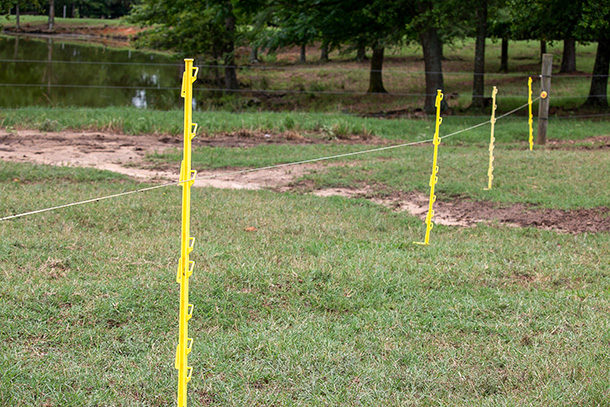Electric fencing changed the game for cattle producers and sustainability on pastureland. Selecting the correct type of fencing for your operational goals impacts the efficiency of your forage and protects resources on your land.
Temporary electric fencing gives cattle owners more flexibility in their management, says Amanda Courtney, owner of Live Wire Products. Different seasons and changing weather conditions are easier to handle with electric fencing because cattle can be moved quickly and easily, she says. “I can isolate and set up 5 acres [of fencing] in an hour.”
Although electric fencing makes moving and rotating cattle simple, here are five things you should be aware of when installing and maintaining electric fencing to increase the longevity and usefulness of your fencing.
1. Invest in proper equipment
“First and foremost, [a producer] needs an energizer that fits the area they want to enclose,” Courtney says.
Energizers are measured in joules, and this is important to consider when purchasing one, she explains. If using a solar panel, 10 watts of energy are needed to power one joule. “Say you are running a two-joule energizer… we would need at least a twenty-watt solar panel to provide the energy to run the energizer,” Courtney says.
Grounding rods give direction for the electricity to travel. Inadequate grounding rods can cause you trouble when setting up fences. They are typically 8 feet in length. However, you can implement shorter grounding rods for rotational grazing for easier mobility. Courtney recommends using two or three rods connected with an insulated cable. This lets you set the rods 3 feet in the ground, rather than 8 feet, and still gives you good ground.
Another important tool for electric fence installation is a charge tester, says Jane Parish, professor and interim head of the department of animal and dairy sciences at Mississippi State University. A voltmeter is a worthy investment for managing electric fences, she says.
2. Maintenance
“Electric fences are low maintenance, but not no maintenance,” Courtney says. Like any type of fencing, it requires consistent observation to ensure insulators, rods, energizers and wires are functioning properly and have not been damaged by cattle. Managing vegetation at fencelines improves electric currents and longevity of equipment. Weeds or grass in contact with wires limits the power of a fence, Courtney says.
Another tip, Parish says, is to keep a fence tester handy when checking cattle and listen for the charge of the fence and energizer.
3. Know your situation
Know your objective and environment before you purchase equipment. The type and moisture content of soil can affect the type of grounding rods needed. Drier soils may require more grounding rods clustered together or longer grounding rods, Parish says. Soils with more moisture are advantageous because they provide better grounding and conduct electricity better.
The type of wire is dependent on the stability you need. If cattle are accustomed to electric fencing, thin polywire is sufficient. However, if cattle need to be trained to electric fencing, tape is a more visual option, Parish says.
4. Weather
As summer approaches, cattle owners need to be cognizant of potential storms and wind. Monitoring wind and rain means preparing for tree limbs to fall on fencing or objects to be blown into the wires.
Having a supply of materials to mend fences or replace insulators is prudent, Parish says. You should monitor and note any areas of fence that could be vulnerable during a storm, she adds.
5. Ask questions
Electric fencing is a widespread tool for cattle ranchers in the U.S., and many resources are available for producers to get their questions answered. County extension offices and local feed supply stores are good places to seek out, Parish says.
Additionally, distributors like Live Wire Products encourage customers to contact them with any questions or concerns regarding the installation or management of fencing, Courtney says. “Do not be afraid to call your distributor or the store you purchased [equipment] from and ask them questions,” she says.
With these five things in mind, you can successfully manage your herd and promote sustainability on your land.







